Discover 35 hidden attractions, cool sights, and unusual things to do in Vicenza (Italy). Don't miss out on these must-see attractions: Villa Capra "La Rotonda", Palazzo Chiericati, and Palazzo Barbaran da Porto. Also, be sure to include Palazzo Porto in your itinerary.
Below, you can find the list of the most amazing places you should visit in Vicenza (Veneto).
Table of Contents
Villa Capra "La Rotonda"
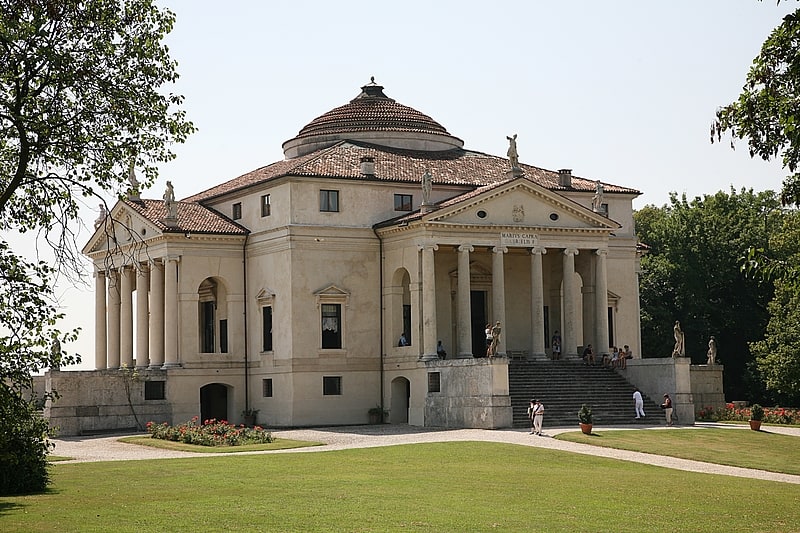
Also known as: Villa Almerico Capra
Renaissance villa hosting private events. Villa La Rotonda is a Renaissance villa just outside Vicenza in northern Italy designed by Italian Renaissance architect Andrea Palladio. The villa’s correct name is Villa Almerico Capra Valmarana, but it is also known as "La Rotonda", "Villa Rotonda", "Villa Capra", and "Villa Almerico Capra". The name Capra derives from the Capra brothers, who completed the building after it was ceded to them in 1592. Along with other works by Palladio, the building is conserved as part of the World Heritage Site "City of Vicenza and the Palladian Villas of the Veneto".[1]
Address: Via della Rotonda, 45, 36100 Vicenza
Palazzo Chiericati
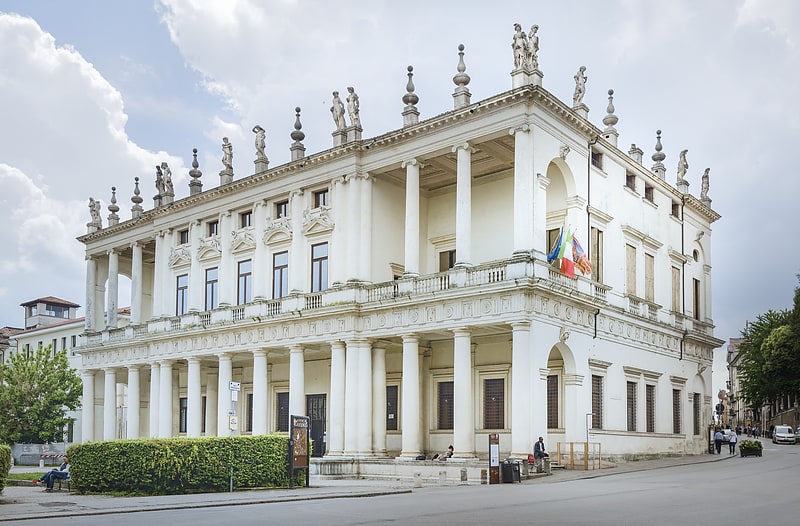
16th-century palace and art museum. The Palazzo Chiericati is a Renaissance palace in Vicenza, designed by Andrea Palladio.[2]
Address: Piazza Giacomo Matteotti, 37/39, 36100 Vicenza
Palazzo Barbaran da Porto

Art museum in Vicenza, Italy. Palazzo Barbaran da Porto is a palazzo in Vicenza, Italy designed in 1569 and built between 1570 and 1575 by Italian Renaissance architect Andrea Palladio.
Since 1994 the palace is part of the "City of Vicenza and the Palladian Villas of the Veneto" World Heritage Site by UNESCO.
In the palace is located the Museo Palladio and the Centro internazionale di studi di architettura Andrea Palladio (CISA).[3]
Address: Contrà Porti, 11, 36100 Vicenza
Palazzo Porto
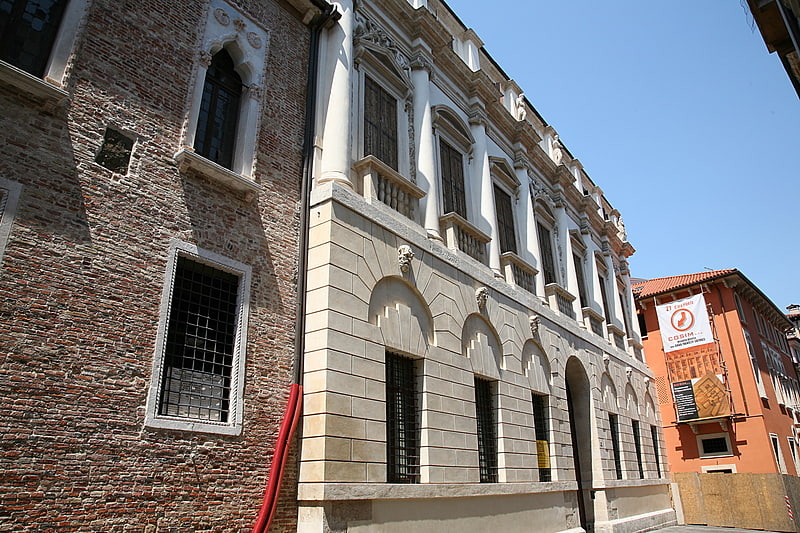
Palace in Vicenza, Italy. Palazzo Porto is a palace built by Italian Renaissance architect Andrea Palladio in Contrà Porti, Vicenza, Italy. It is one of two palaces in the city designed by Palladio for members of the Porto family. Commissioned by the noble Iseppo da Porto, just married, this building had a rather long designing stage and a longer and troublesome realization, partially unfinished.
In 1994, UNESCO included the palazzo in a World Heritage Site, the "City of Vicenza and the Palladian Villas of the Veneto".[4]
Monte Berico

Church in Vicenza, Italy. The Church of St. Mary of Mount Berico is a Roman Catholic and minor basilica in Vicenza, northern Italy. The church is a Marian shrine, and stands at the top of a hill which overlooks the city.[5]
Address: Viale 10 giugno, 36100 Vicenza
Palazzo del Capitaniato

Historical landmark in Vicenza, Italy. The palazzo del Capitaniato, also known as loggia del Capitanio or loggia Bernarda, is a palazzo in Vicenza, northern Italy, designed by Andrea Palladio in 1565 and built between 1571 and 1572. It is located on the central Piazza dei Signori, facing the Basilica Palladiana.
The palazzo is currently used by the town council, inside the Sala Bernarda. It was decorated by Lorenzo Rubini and, in the interior, with frescoes by Giovanni Antonio Fasolo. Since 1994 the palace has been part of the UNESCO World Heritage Site of the "City of Vicenza and the Palladian Villas of the Veneto".[6]
Address: Piazza Dei Signori VI, 36100 Vicenza
Palazzo Valmarana
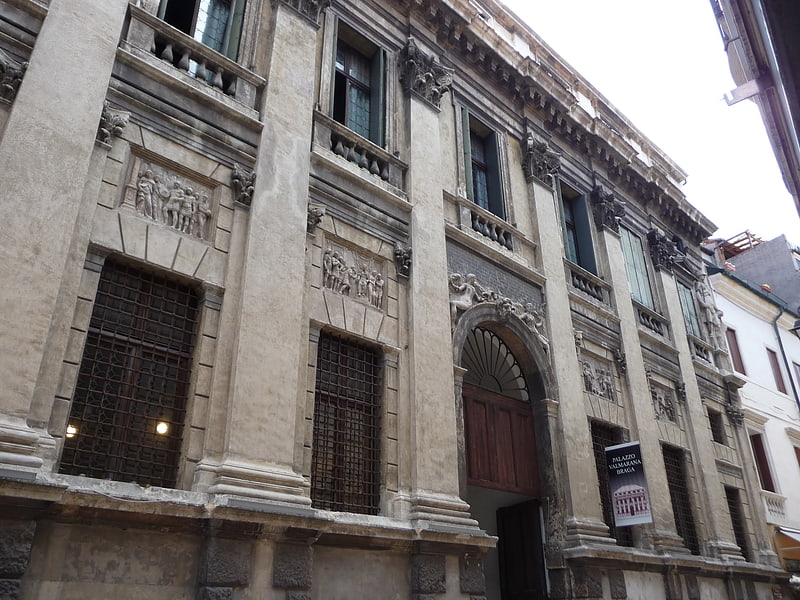
Palace in Vicenza, Italy. Palazzo Valmarana is a palace in Vicenza. It was built by Italian Renaissance architect Andrea Palladio in 1565 for the noblewoman Isabella Nogarola Valmarana. Since 1994 it is part of the UNESCO World Heritage Site "City of Vicenza and the Palladian Villas of the Veneto".[7]
Address: Corso Antonio Fogazzaro 16, 36100 Vicenza
Palazzo Thiene
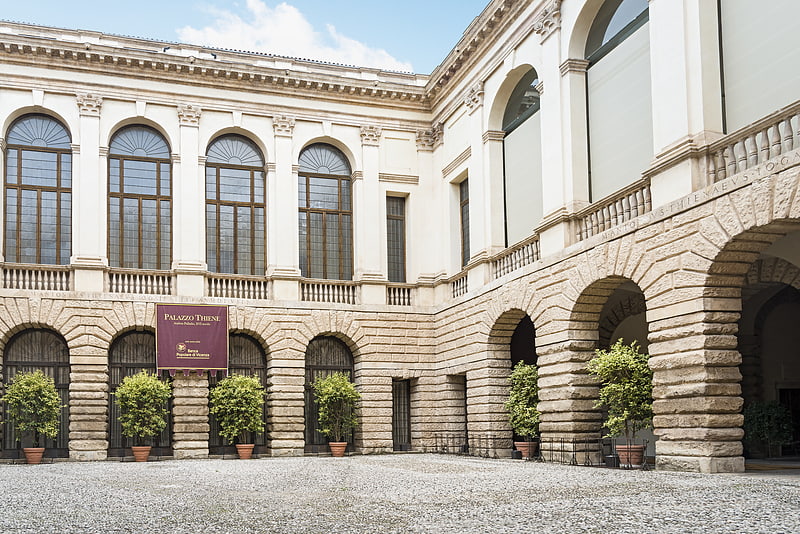
Tourist attraction in Vicenza, Italy. Palazzo Thiene is a 15th-16th-century palace in Vicenza, northern Italy, designed for Marcantonio and Adriano Thiene, probably by Giulio Romano, in 1542, and revised during construction from 1544 by Andrea Palladio.
In 1994, the palace was included in the "Vicenza, city of Palladio" World Heritage Site by UNESCO. In 1996, the World Heritage Site was renamed "City of Vicenza and the Palladian Villas of the Veneto", and it was expanded to include outlying villas (one of which is the Thiene brothers' country home, the Villa Thiene). The palace is used as the historic headquarters of a bank and it also hosts some exhibitions and culture events.
The palazzo was the headquarters of Banca Popolare di Vicenza.[8]
Address: Contra San Gaetano Thiene, Vicenza
Teatro Olimpico
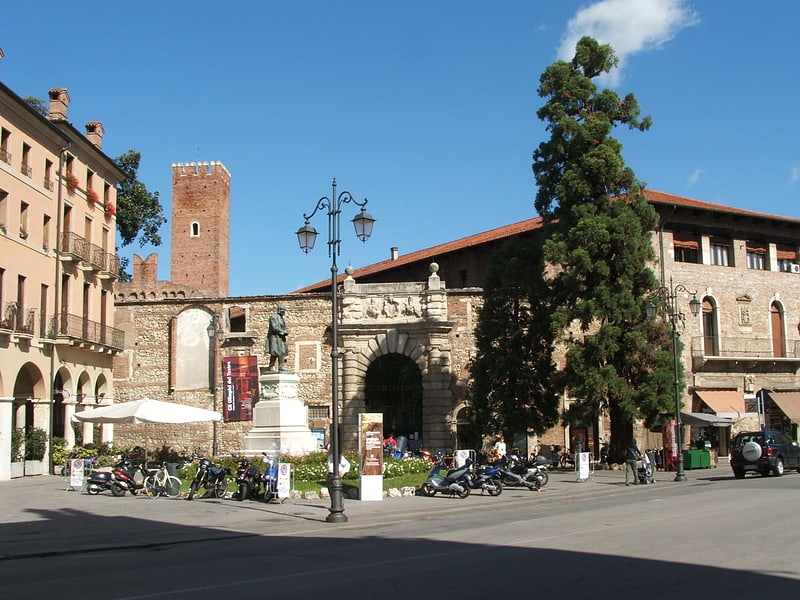
Theatre in Vicenza, Italy. The Teatro Olimpico is a theatre in Vicenza, northern Italy, constructed in 1580–1585. The theatre was the final design by the Italian Renaissance architect Andrea Palladio and was not completed until after his death. The trompe-l'œil onstage scenery, designed by Vincenzo Scamozzi, to give the appearance of long streets receding to a distant horizon, was installed in 1585 for the first performance held in the theatre, and is the oldest surviving stage set still in existence. The full Roman-style scaenae frons back screen across the stage is made from wood and stucco imitating marble. It was the home of the Accademia Olimpica, which was founded there in 1555.
The Teatro Olimpico is, along with the Teatro all'antica in Sabbioneta and the Teatro Farnese in Parma, one of only three Renaissance theatres remaining in existence. Both these theatres were based, in large measure, on the Teatro Olimpico. It is still used several times a year.
Since 1994 the Teatro Olimpico, together with other Palladian buildings in and around Vicenza, has been part of the UNESCO World Heritage Site "City of Vicenza and the Palladian Villas of the Veneto".[9]
Address: Piazza Giacomo Matteotti 11, 36100 Vicenza
Basilica Palladiana
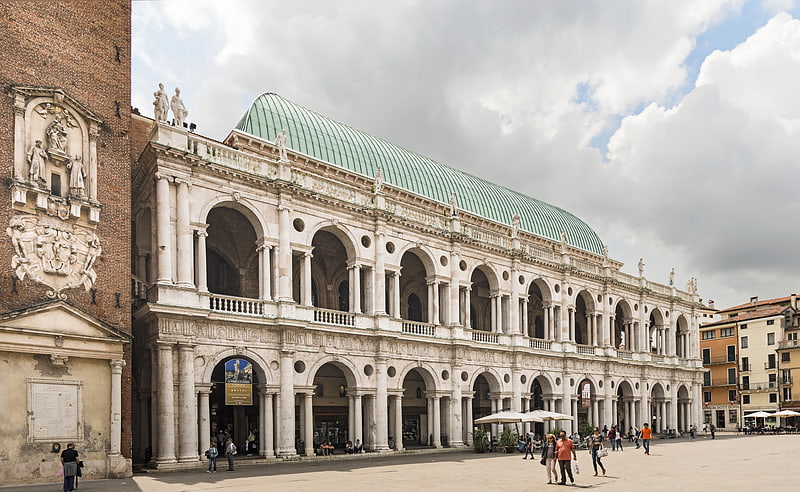
Iconic building for cultural exhibitions. The Basilica Palladiana is a Renaissance building in the central Piazza dei Signori in Vicenza, north-eastern Italy. The most notable feature of the edifice is the loggia, which shows one of the first examples of what have come to be known as the Palladian window, designed by a young Andrea Palladio, whose work in architecture was to have a significant effect on the field during the Renaissance and later periods.
Since 1994, the Basilica Palladiana, together with other Palladian buildings in and around Vicenza, has been part of the UNESCO World Heritage Site "City of Vicenza and the Palladian Villas of the Veneto".[10]
Address: Piazzetta andrea palladio, 12, 36100 Vicenza
Palazzo Thiene Bonin Longare

Palace in Vicenza, Italy. Palazzo Thiene Bonin Longare is a patrician palace in Vicenza, northern Italy, designed by Italian Renaissance architect Andrea Palladio, probably in 1572, and built after Palladio's death by Vincenzo Scamozzi. It is one of the city palazzi of the Thiene family that Palladio worked upon, the other being Palazzo Thiene in the near contrà Porti.
Since 1994 the palace has formed part of a UNESCO World Heritage Site the current name of which is "City of Vicenza and the Palladian Villas of the Veneto".[11]
Address: Corso Andrea Palladio 13, 36100 Vicenza
Palazzo Civena
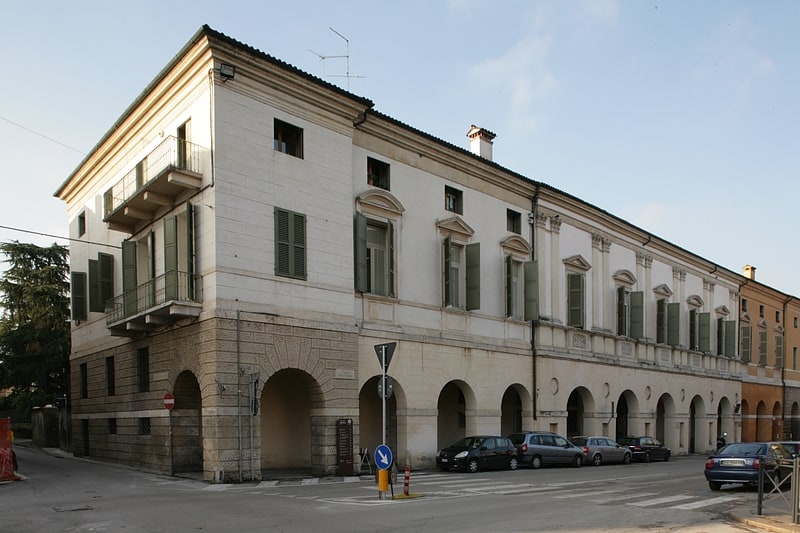
Palace in Vicenza, Italy. Palazzo Civena is a Renaissance palace in Vicenza, Italy, dating to 1540. It was the first city palace designed by Andrea Palladio. The palace was constructed for the brothers Giovanni Giacomo, Pier Antonio, Vincenzo, and Francesco Civena.[12]
Vicenza Cathedral
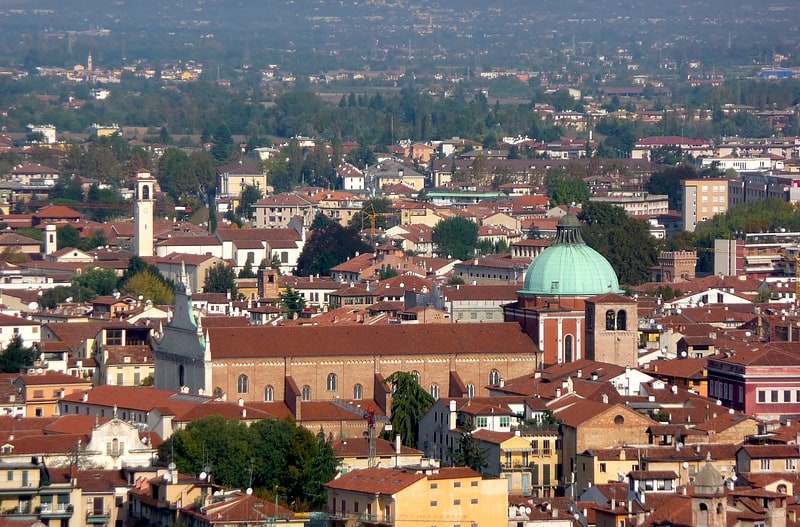
Also known as: Cattedrale di Santa Maria Annunciata
Cathedral in Vicenza, Italy. Vicenza Cathedral is a Roman Catholic cathedral in Vicenza, Veneto, northern Italy. It is the seat of the Bishop of Vicenza, and is dedicated to the Annunciation of the Virgin Mary.[13]
Address: Piazza del Duomo 8, 36100 Vicenza
Stadio Romeo Menti
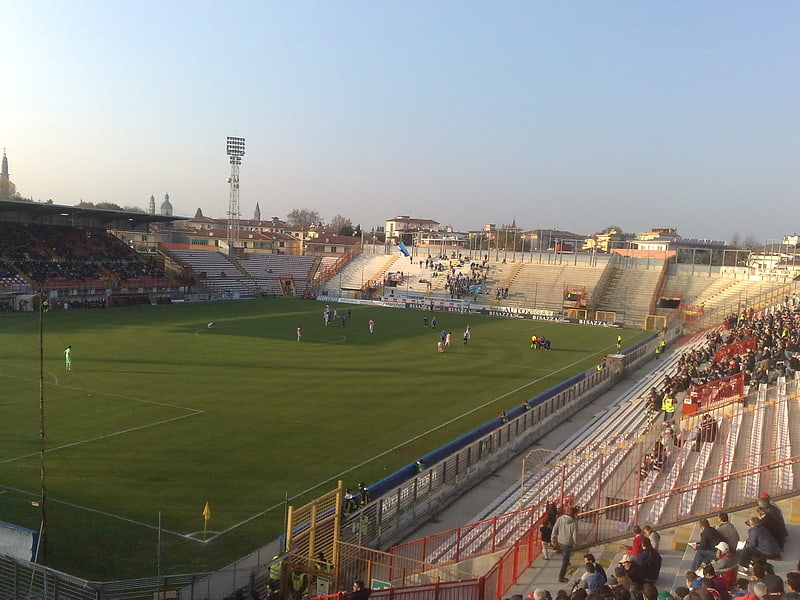
Stadium in Vicenza, Italy. Stadio Romeo Menti is a football stadium in Vicenza, Italy, named after Romeo Menti. It is currently the home of Vicenza Calcio. The stadium holds 12,000.[14]
Address: Via Schio 21, 36100 Vicenza
Palazzo Schio

Palace in Vicenza, Italy. Palazzo Schio is a patrician palace of the 16th century in Vicenza, northern Italy, whose facade was designed by the Italian Renaissance architect Andrea Palladio in 1560.[15]
Address: Contrà S. Marco, 39, 36100 Vicenza
Palazzo Porto
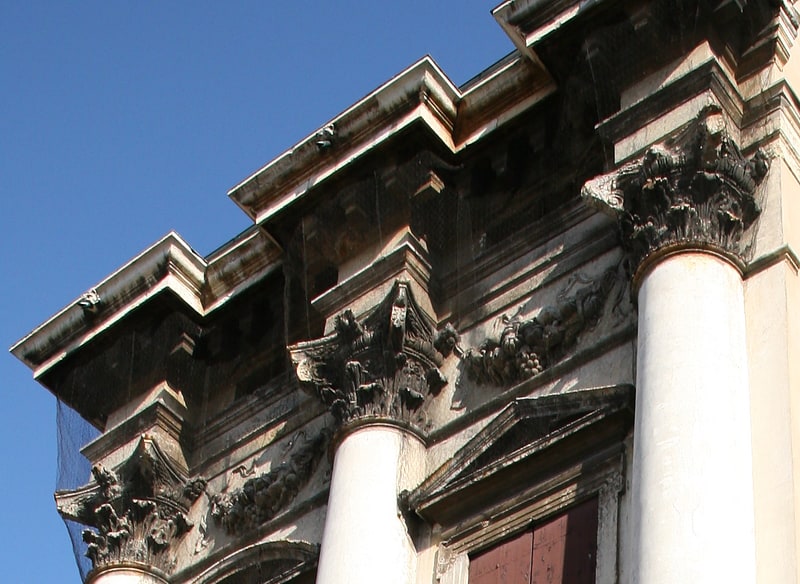
Palace. The Palazzo Porto is a palace in Piazza Castello, Vicenza, northern Italy. It is one of two palazzi in the city designed by Andrea Palladio for members of the Porto family. Only two bays of it were ever built, beginning shortly after 1571. Why the patron, Alessandro Porto, did not continue with the project is not known.[16]
Address: Piazza del Castello 18, 36100 Vicenza
Church of San Filippo Neri
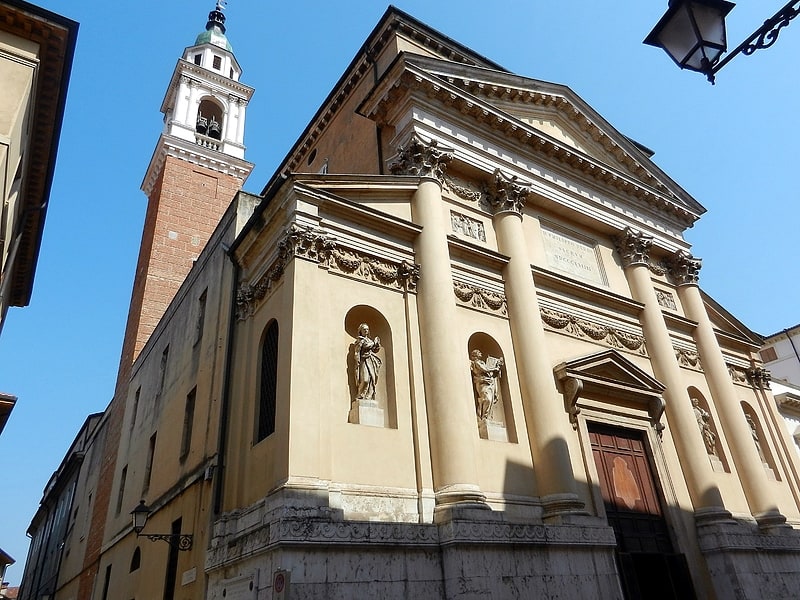
Also known as: Chiesa di San Filippo Neri
San Filippo Neri, also called the Chiesa dei Filippini or San Marcello in San Filippo Neri, is a Neoclassical-style, Roman Catholic church located on Corso Palladio #35 in the city of Vicenza, region of Veneto, Italy.[17]
Address: Corso Andrea Palladio, Vicenza
Casa Cogollo
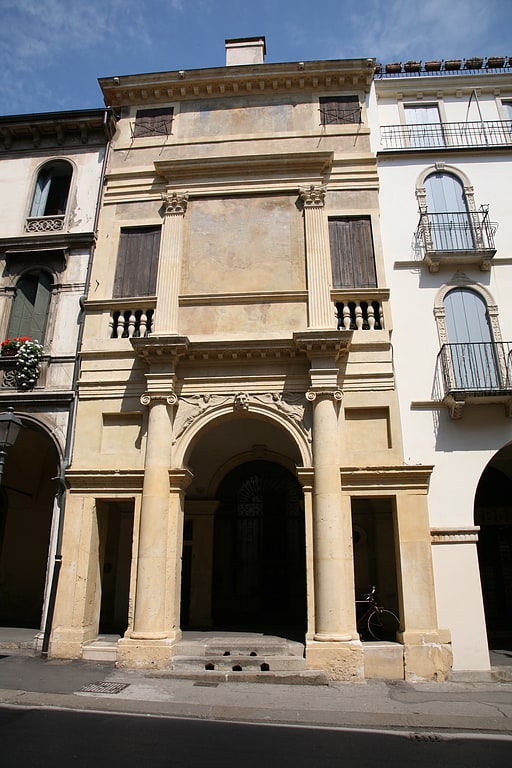
16th century palace with ionic columns. Casa Cogollo is a small palazzo in Vicenza built in 1559 and attributed to architect Andrea Palladio. Since 1994 it has formed part of the UNESCO World Heritage Site "City of Vicenza and the Palladian Villas of the Veneto".
Though known as the “House of Palladio”, in reality this building has no connection with the residence of the Vicentine master. Rather it is its dimensions—quite contained in comparison to the monumental emphasis of other Palladian palazzi—which has led astray those seeking a trace of the architect’s residence in the city.
In fact, the Maggior Consiglio (town council) forced the notary Pietro Cogollo to remodel the façade of his 15th century (Quattrocento) house as a contribution to the “decorum of the city”, making this provision (and a monetary investment in the work of not less than 250 ducats) a condition of their positive response to his request for Vicentine citizenship.
In the absence of documents and autograph designs, the attribution to Palladio of this most elegant façade still divides scholars. Yet, because of the intelligence of the architectural solution proposed, as well as the design of all the details, it is difficult to refer the project to any other designer. The constraints posed by a narrow space and the impossibility of opening windows at the centre of the piano nobile (because of an existing fireplace and its flue) induced Palladio to emphasise the façade’s central axis, by realising a structure with a ground floor arch flanked by engaged columns, and on the upper storey a tabernacle frame for a fresco by Giovanni Antonio Fasolo.
The ground level arch is flanked by two rectangular spaces which illuminate and provide access to the portico. Altogether they form a type of serliana, as already done at the Basilica Palladiana. The result is a composition of great monumental and expressive force, despite the simplicity of the means available.[18]
Palazzo Pojana
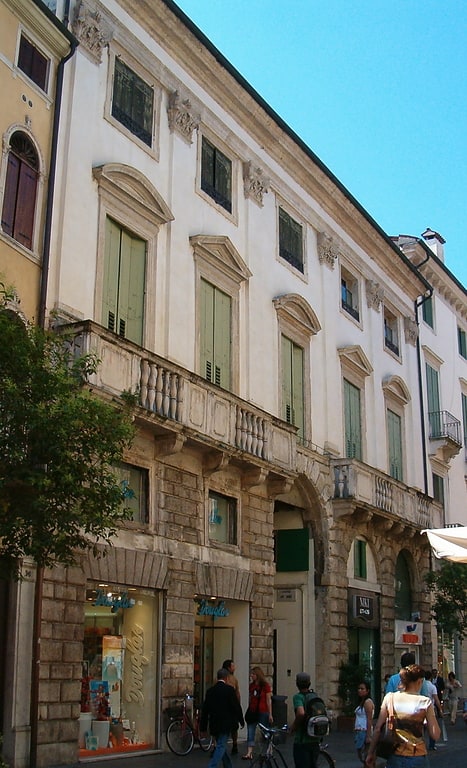
Palace. Palazzo Pojana is a patrician palace in Vicenza, northern Italy, attributed to the Italian Renaissance architect Andrea Palladio, about 1560.[19]
Address: Corso Andrea Palladio, Vicenza
Chiesa di Santa Corona
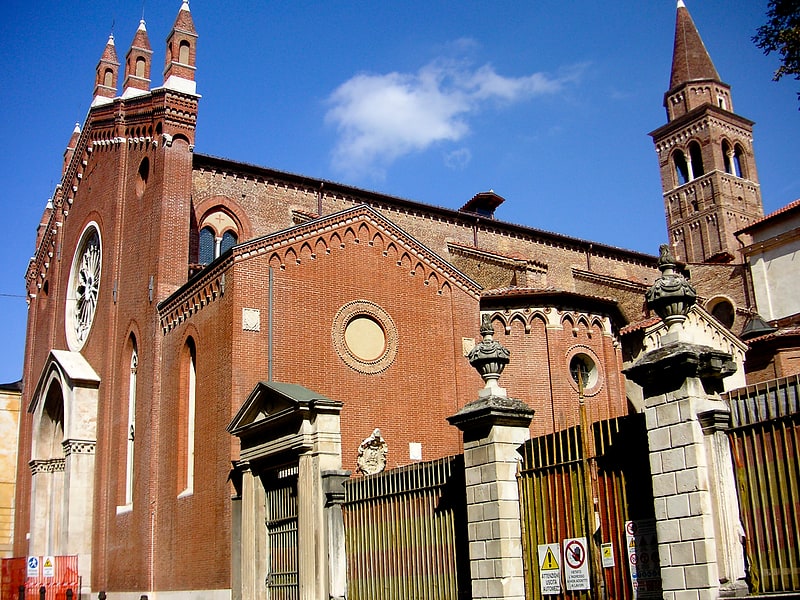
Catholic church in Vicenza, Italy. Santa Corona is a Gothic-style, Roman Catholic church located in Vicenza, region of Veneto, Italy. The church contains the Valmarana chapel, whose design is attributed to the Renaissance architect Andrea Palladio. Palladio himself was initially buried in this church.[20]
Address: Contra Santa Corona 2, 36100 Vicenza
Teatro Comunale Città di Vicenza
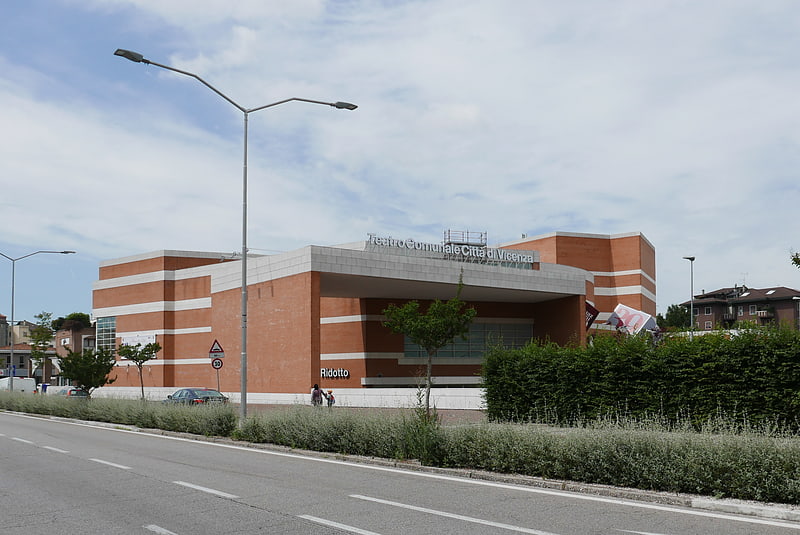
Also known as: Teatro comunale Città di Vicenza
Performing arts theater in Vicenza, Italy. Teatro Comunale Città di Vicenza is a modern theatre structure consisting of a main hall, the “Sala Maggiore”, with 910 seats and a second one with 380 seats, and the so-called “Ridotto”. The structure was planned by the architect Gino Valle and inaugurated in December 2007. It is located in Vicenza, Italy, a city included in the World Heritage List UNESCO, not far away to Venice.[21]
Address: Viale Giuseppe Mazzini 39, 36100 Vicenza
Chiesa di San Marco in San Girolamo
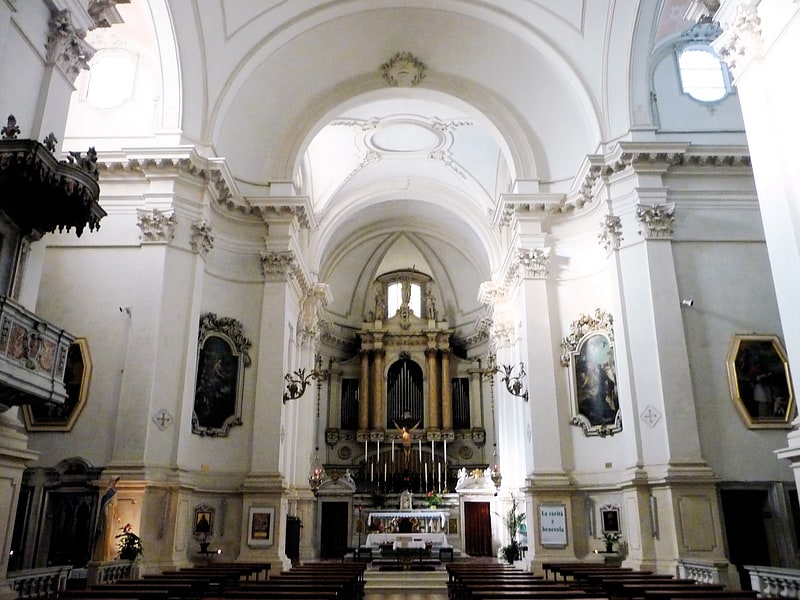
Parish church in Vicenza, Italy. The Church of San Marco in San Girolamo is a baroque parish church in Vicenza, northern Italy, built in the 18th century by the Discalced Carmelites. It houses various artworks by artists of the early 18th century from Veneto. The sacristy preserves its original furniture of the same period.[22]
Address: Contra San Francesco 78, 36100 Vicenza
Piazza dei Signori

Historical landmark in Vicenza, Italy. Piazza dei Signori is a city square in Vicenza, Italy.[23]
Address: Piazza dei Signori, 36100 Vicenza
Loggia Valmarana
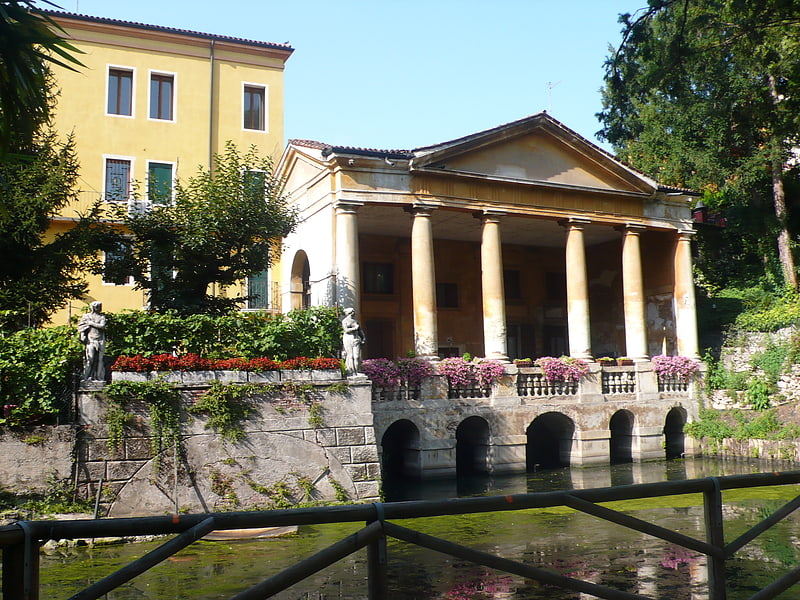
The Loggia Valmarana located inside the Salvi gardens, also called Valmarana Salvi gardens, was probably built in 1591 by a student of Andrea Palladio by the will of Gian Luigi Valmarana himself, who wanted this place become a meeting point between intellectuals and academics.
Since 1994 it is part of the City of Vicenza and the Palladian Villas of the Veneto forming the World Heritage Site of the Unesco.[24]
Biblioteca Civica Bertoliana
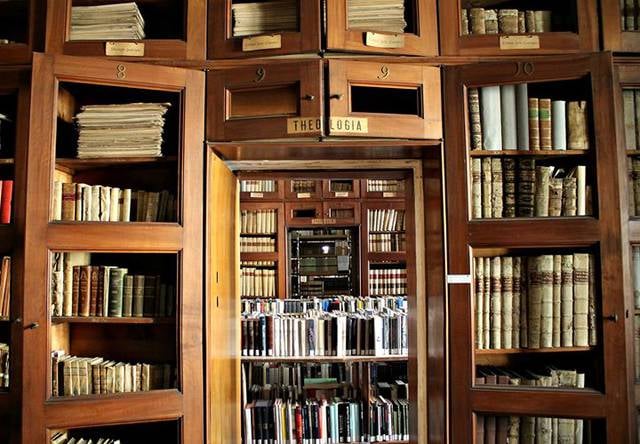
The Biblioteca Civica Bertoliana is a main public library of the municipality of Vicenza, Italy. Inaugurated at the dawn of the 18th-century, and now the third largest library in the Veneto, after the Biblioteca Marciana of Venice and the University of Padua library. The main office is located in the Palazzo San Giacomo, Vicenza.[25]
Address: Contra Riale 5, 36100 Vicenza
Santa Maria in Araceli
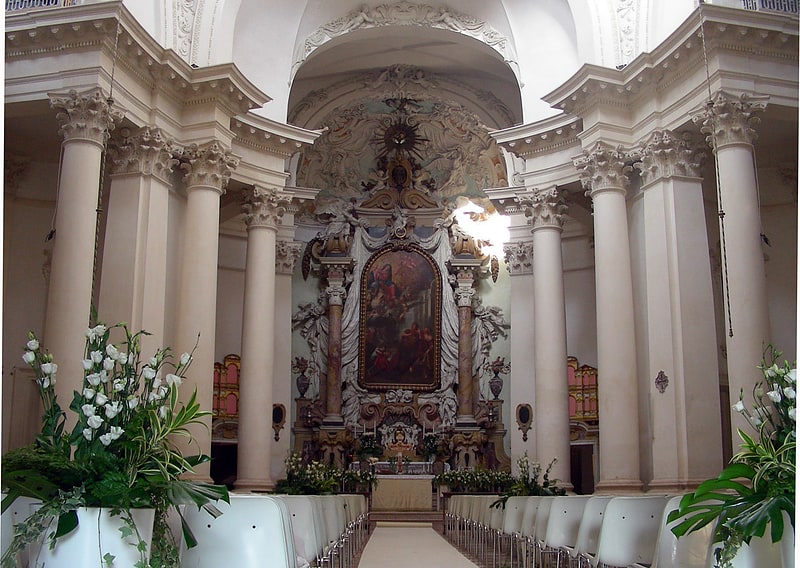
Catholic church in Vicenza, Italy. The church of Santa Maria in Araceli is a late-Baroque style church built in the late 17th century in Vicenza according to designs attributed to Guarino Guarini.
Documents first take note of a church at the site, dating from 1241. They refer to a church of Santa Maria in the area that stood near a convent. This convent, which in 1277 belonged to the Clarisse Nuns, was called Santa Maria ad Cellam,. The suffix was then modified to alla cella, then Arcella and finally to Araceli. This church in Vicenza should not be confused with the church Santa Maria in Aracoeli in central Rome.
Construction of the present church was begun during 1672-1680, a period during which the famous architect Guarino Guarini resided in Vicenza under the patronage of the Theatines. In 1965, designs for the church were found in the Vatican Library. Construction seems to have been guided by Carlo Borella. It was about 60 years after the start of construction, on November 17, 1743, that the church was consecrated. In 1810, during the Napoleonic occupation, the convent was expropriated, and the church became a parish church. The church was replaced by a new parish church, Cristo Re, in 1960. This church ceased being used until restoration in finished in 1990.
The main baroque altar, was carved in marble by Tommaso Bezzi. It contains an altarpiece representing the Tiburtine Sybil who portends the coming Virgin and Child to the Roman Emperor Augustus attributed to Pietro Liberi. The altar on the right has a 13th-century painted crucifix, originally from church of San Vito.[26]
Address: Piazza Araceli 21, 36100 Vicenza
Arco delle Scalette
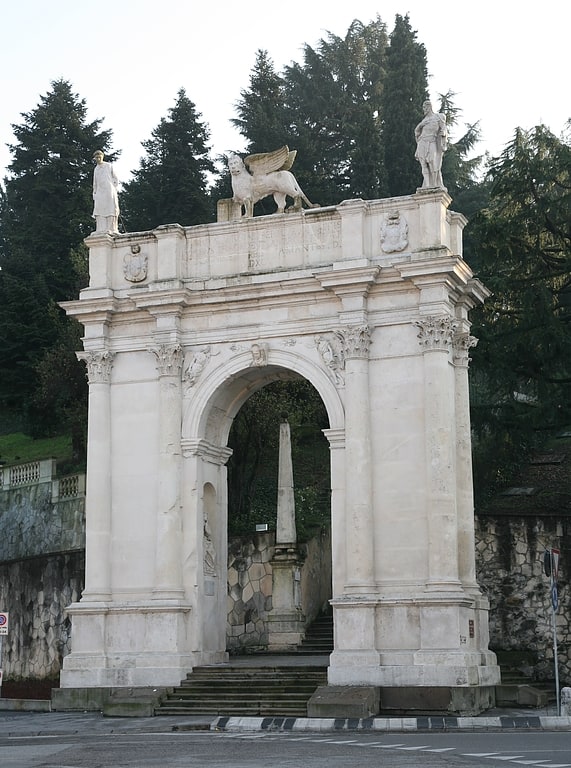
Tourist attraction in Vicenza, Italy. The Arco delle Scalette is an arch in Vicenza, built in 1596, whose design is attributed to the architect Andrea Palladio.
Since 1994 the arch has been part of a World Heritage Site, designated to protect the Palladian buildings of Vicenza it as "City of Vicenza and the Palladian Villas of the Veneto".
Located in the south-eastern border of the historic center of the city, the arch marks the beginning of one of the routes climbing to the sanctuary of St. Mary of Monte Berico (built in the early 15th century). The path, called the "Scalette", is a series of stairs with 192 steps. That was the only point of access from the city to the sanctuary before the building of the arcades by Francesco Muttoni in the mid-18th century.
The origins and authenticity of the arch are unclear. The date of construction, set to 1595 (15 years after Palladio's death), is certain, like the identity of the patron, the Venetian captain Giacomo Bragadin. There are documented demands of the monks of the sanctuary, dating from 1574-1576, asking the community for financial support for the restoration of the entire path of stairs, but there is no evidence that the arch was included in the general renewal process, which involved the sanctuary itself. At the same way, the original configuration of the arch is uncertain. 17th century images shows the niches in the front of the arch, then moved in the intrados to host the statues of the Annunciation by Orazio Marinali.[27]
Address: Piazzale Fraccon, 8, Vicenza
Torre Bissara
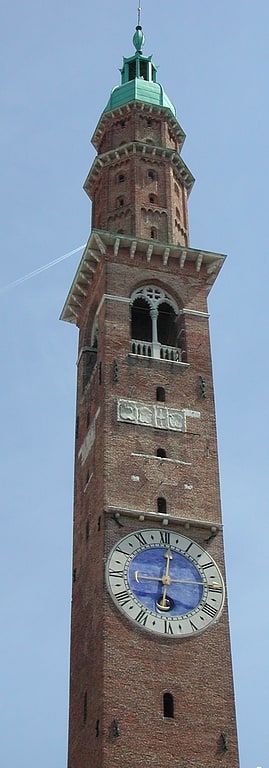
Tourist attraction in Vicenza, Italy. Torre Bissara is a tower in Piazza dei Signori, Vicenza, Italy.[28]
Address: Piazza dei Signori, Vicenza
Palazzo Leoni Montanari

Also known as: Gallerie di palazzo Leoni Montanari
Palace in Vicenza, Italy. The Palazzo Leoni Montanari is a late Baroque palace located in Contra’ San Corona number 25 in central Vicenza in the Veneto region of Italy. It now houses exhibition rooms, meeting places, and art collections owned by the bank Intesa Sanpaolo.[29]
Address: Contrà Santa Corona, 25, 36100 Vicenza
Santa Maria Nova
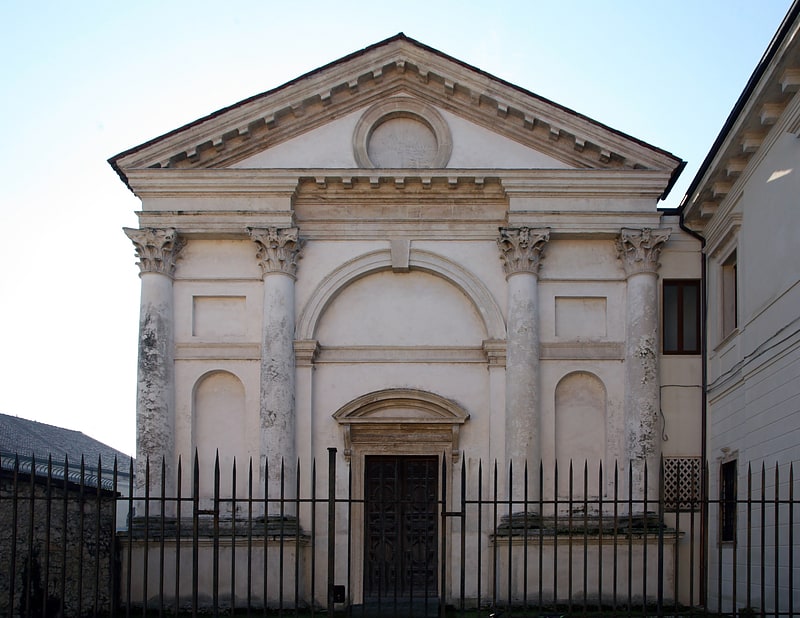
Catholic church in Vicenza, Italy. Santa Maria Nova is a Roman Catholic church in Vicenza attributed to 1578 designs by Italian Renaissance architect Andrea Palladio. It is the only complete church design in Vicenza assigned to Palladio, although he did design the Valmarana chapel in Santa Corona, a portal and the cupola of the Cathedral, and the portal of Santa Maria dei Servi.[30]
Address: Contrada Santa Maria SNC, 75020 Vicenza
Oratorio di San Nicola
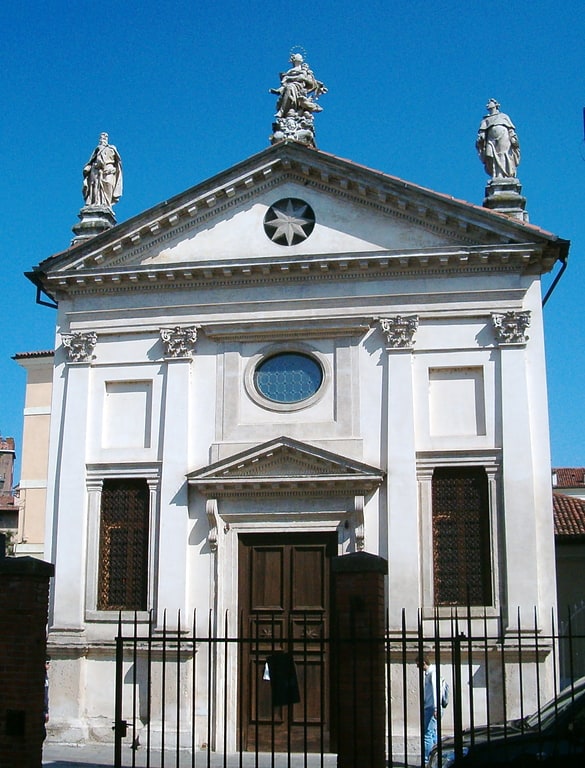
Church in Vicenza, Italy. The Oratory of San Nicola da Tolentino is a small chapel like structure in Vicenza, which is notable for its excellent collection of 16th- and 17th-century paintings.[31]
Address: Stradella S. Nicola, 2, 36100 Vicenza
Villa Valmarana ai Nani
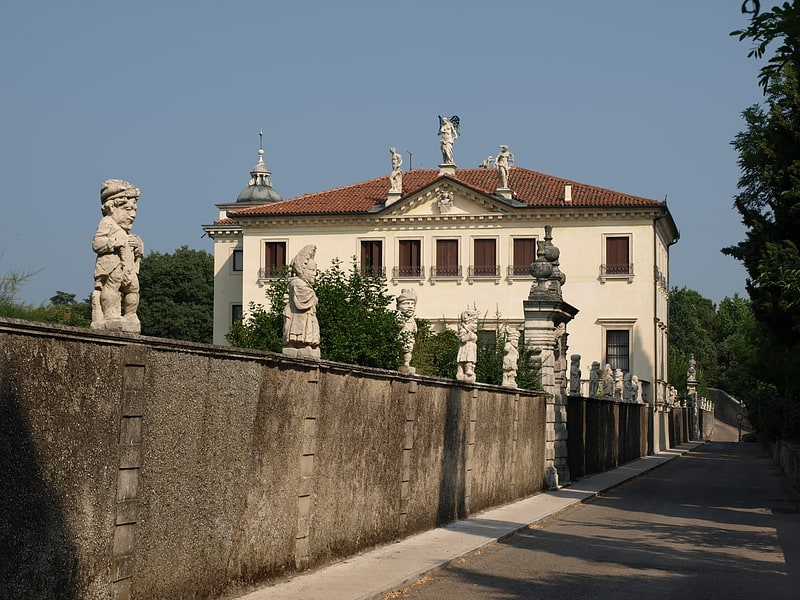
Cultural landmark in Vicenza, Italy. Villa Valmarana ai Nani is a villa at the foot of the gates of the city of Vincenza, Veneto, Italy. The main building was completed in 1670. It is noted for its frescos by Giambattista and Giovanni Domenico Tiepolo and stone sculptures of dwarves named "Nani".
The villa is named Villa Valmarana ai Nani therein to differentiate it from other villas named Valmarana, especially the very famous Villa Capra "La Rotonda" designed by Andrea Palladio and formerly owned by Mario di Valmarana, a member of another branch of the same family. Villa Valmarana ai Nani was purchased by a set of brothers from the aristocratic Valmarana family in 1720 and is still owned by their descendants.[32]
Address: Via dei Nani, 8, 36100 Vicenza
International Library La Vigna

Also known as: Biblioteca internazionale La Vigna
Library in Vicenza, Italy. Centro di Cultura e Civiltà Contadina - Biblioteca Internazionale La Vigna is an institute of documentation specialised in studies concerning agriculture and wine. It is considered as the most important reference point for ampelographic research worldwide. It is situated in Vicenza in Contrà Porta Santa Croce n. 3 in Palazzo Brusarosco, then Galla. The palace is an eighteenth-century building, which was partially restored by the architect Carlo Scarpa.[33]
Address: Contra Porta Santa Croce 3, 36100 Vicenza
Villa Gazzotti
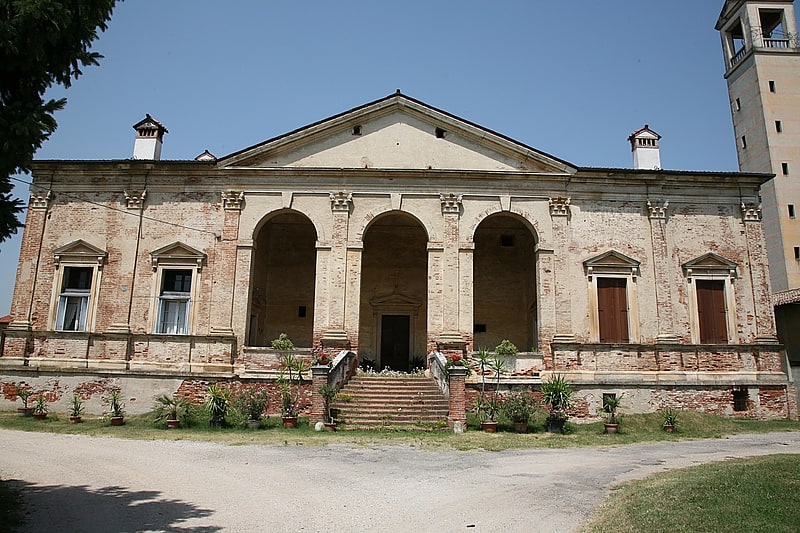
The Villa Gazzotti Grimani is a Renaissance villa, an early work of architect Andrea Palladio, located in the village of Bertesina, near Vicenza in the Veneto region of northern Italy.
In 1994 UNESCO designated Villa Gazzotti Grimani as part of the "Vicenza, City of Palladio" World Heritage Site. Two years later the World Heritage Site was expanded to include Palladian villas outside the core area and accordingly it was renamed as "City of Vicenza and Palladian Villas of the Veneto".[34]
Address: Via San Cristoforo 23, 36100 Bertesina
Chiesa Santi Felice e Fortunato

The basilica of Santi Felice e Fortunato is a church in Vicenza, currently the parish seat, whose origin dates back to the 4th-5th centuries; its present Romanesque appearance is substantially due to reconstruction in the 12th and 20th-century restorations.
For over a millennium the basilica was attached to the most important Benedictine abbey in the Vicenza area.
Address: Corso SS. Felice e Fortunato, 286, 36100 Vicenza